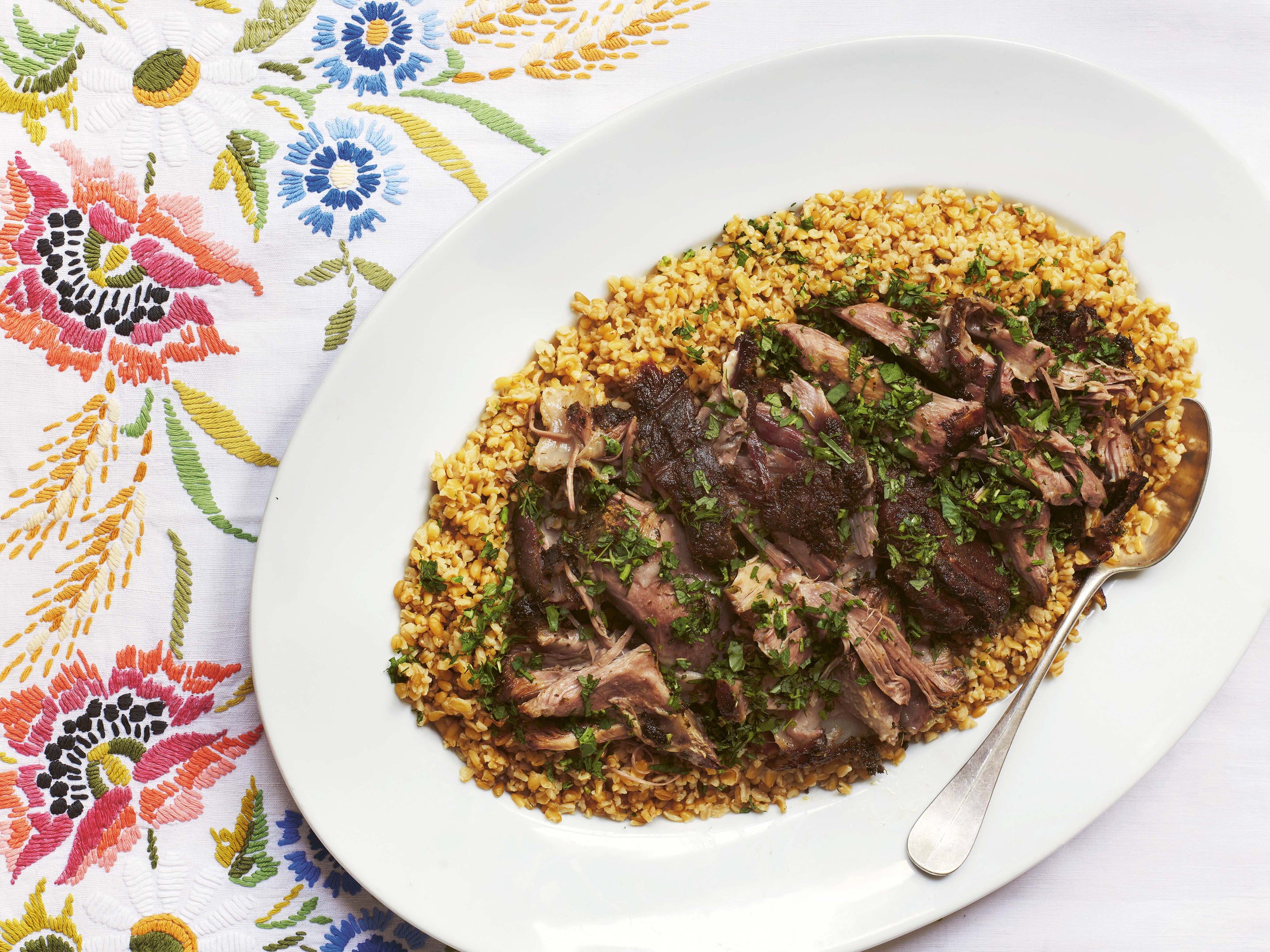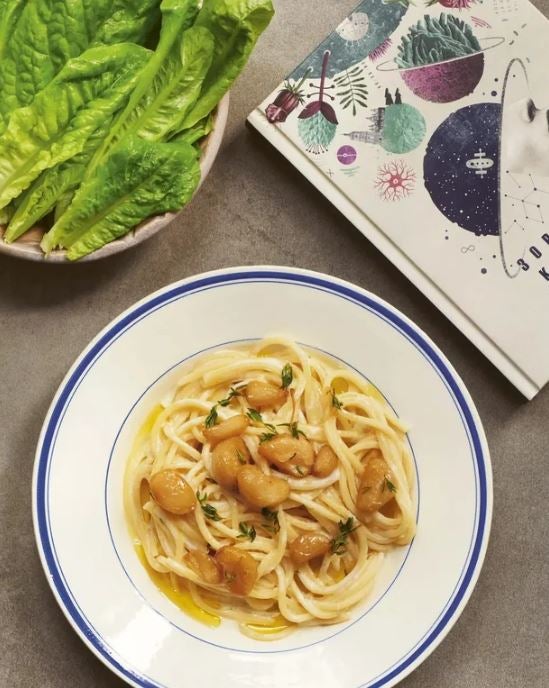Cook for Ukraine: Three recipes for special occasions
Impress your guests for a good cause with these dishes from Olia Hercules’ new cookbook ‘Home Food’, says Prudence Wade

The marinade ingredients might sound fusion-y and improbable, but they work so well,” Olia Hercules says. “When you pull the lamb and mix it through the marinade juices, it’s just incredible. This recipe is fantastic for using up tired, soft fridge-forgotten herbs: feel free to use any, such as parsley, chives and basil.
“Serve it with any grain, too – I like couscous or freekeh – but any slightly plain carb that can soak up the sauce is good: rice, boiled and crushed potatoes, flatbreads… You name it. Lamb shanks or pork or beef ribs will also work here if you want something smaller or cheaper than a lamb shoulder!”
Lamb shoulder with herbs and preserved lemons
Serves: 6-8
Ingredients:
3 garlic cloves, peeled
1 tbsp soy sauce
½ tbsp honey
15g finely grated ginger (I don’t bother peeling it, but that’s up to you)
1½ tsp ground coriander seeds
1½ tsp ground cumin seeds
Leaves from ½ small bunch of mint
Leaves from ½ small bunch of tarragon
½ small bunch of dill, leaves and stalks
½ small bunch of coriander, leaves and stalks
1 tbsp olive oil
1 preserved lemon, chopped
1 shoulder of lamb (2kg), or 4 lamb shanks
Sea salt
Method:
1. Preheat the oven to 200C fan. Put all the ingredients (bar a handful of soft herbs and the lamb) into a food processor, add half a teaspoon of salt and blitz them up into a paste. Cover the lamb with it. If you can leave it in the marinade overnight, all the better, but if you don’t have time, it is ready to be baked straight away.
2. Put the lamb and marinade into a cast-iron pan and cover it with a lid. Otherwise, especially if you are using a shoulder, you can also use a roasting tin and cover it tightly with a foil tent (just use two large pieces of foil and tent them over the meat without touching it). Cook for 30 minutes, then reduce the oven temperature to 160C fan and cook for another two hours. Then lift the lid or foil off and have a look. The meat should be soft and coming away from the bone. If it is not quite there, cover it again and put it back in for another 30 minutes. Be careful not to dry out the lamb and keep checking, as a shoulder can take up to three-and-a-half hours.
3. Take the lamb out of the oven, cover and rest in its juices for at least 20 minutes.
4. Pull the meat off the bone, discard the bones and large bits of fat, roughly shred larger pieces, then return to the tin. Taste, it may need a light sprinkling of salt.
5. If the lamb has been resting a while, you can pop it and the juices in the roasting tin under a hot grill to warm through and crisp up the meat on top.
6. Of course you can shred the lamb and mix it with the juices up to a day before and keep in the fridge, then just reheat in a lidded pan with a splash of water mixed in, or in a foil baking tray, before serving. Serve with any plain grain you fancy, or even crushed boiled potatoes, sprinkling over the reserved herbs.
Brown butter, miso and walnut cake

At the beginning of 2020, I gave myself permission to have as much cake as I wanted to eat, and I have never regretted that decision,” says Hercules.
This is one of the cakes she returned to time and time again. When making it yourself, Hercules says: “Just be mindful of the potency of your miso: some are saltier than others, so try the recipe with less if you feel yours may be extra-flavourful and salty. I often use a reduced-salt version for this cake.”
Serves: 9
Ingredients:
For the cake:
250g unsalted butter
30g reduced-salt miso paste
225g caster sugar
3 eggs
225g self-raising flour
50ml full-fat yogurt
40g broken walnuts
For the syrup:
50g white sugar
50ml water
20g reduced-salt miso paste
40g walnuts, chopped
Method:
1. A couple of hours before you bake, put the butter in a small pan and heat until it bubbles gently. Use a whisk to scrape the base and sides of the pan, so the milk solids don’t burn. From the moment all the butter melts it should take three to four minutes over a medium heat. Have a bowl ready, to tip the brown butter into when it is ready. It will start smelling like butterscotch, its colour changing from light gold to amber, and its bubbling sound will quieten. Pour it into the bowl.
2. Whisk the miso into the warm butter; you should have 225g of butter mix. Put it into a container and leave it to cool and firm up (stir it a couple of times while it sets, to re-emulsify). You want it to be soft, like room-temperature butter.
3. Preheat the oven to 170C fan. Line a 20-centimetre square or round cake tin, or a 900-gram loaf tin, with baking parchment.
4. Put the cooled brown butter-miso mix in a mixing bowl, or the bowl of a food mixer, together with the sugar. Beat for five minutes with electric beaters or the food mixer at a high speed. (If you’re doing it by hand, beat it for a little longer.)
5. Beat the eggs one at a time into the mixture, scraping down the bowl in between each. Add the self-raising flour and fold it in carefully by hand with a spatula. I know this bit will feel weird – to add yogurt at the end, after the flour – but don’t worry. It works. So mix in the yogurt, again by hand. Spread the batter into the prepared tin, scatter the walnuts over, then push them into the batter slightly.
6. Bake for 40-50 minutes, or until a skewer comes out clean. Leave to cool.
7. While it is cooling, in a pan dissolve the sugar in the measured water. Take it off the heat, add the miso and whisk it all together. Add the chopped walnuts and put the pan back over the medium heat for a couple of minutes, stirring the whole time. Spread the syrup over the cake, let it cool slightly, then enjoy!
Pasta with confit garlic, goat’s cheese and thyme

“I don’t normally find much pleasure in cooking for just me. Except when it’s this dish,” says Hercules.
“This is adapted from an old Nigel Slater recipe, a writer who inspired me and so many others to look beyond cookbook recipes and to cook more freely and creatively. I turn to this recipe time and again when I have some moments on my own.”
She always serves lettuce leaves on the side, to mop up the pasta sauce with a bit of crunch.
Serves:
Ingredients:
2 small garlic bulbs (yes, that’s correct, 1 per person)
100ml good olive oil
Leaves from 4 thyme sprigs
200g spaghetti or linguine
200g soft goat’s cheese (logs are good)
To serve:
Lettuce leaves
Good vinegar
Sea salt
Method:
1. I haven’t yet found a garlic peeling hack that works. What I do is separate the cloves, then attempt to lightly bash on each with the heel of my hand and cut off the dry root end. The skins then slip off quite easily. If you accidentally squash some (or a lot, like I do, heavy-handedly) of the cloves, don’t worry too much, they can still be used. Put the oil into the smallest saucepan or frying pan you have, heat it gently and spoon in the garlic. The cloves should be submerged in oil and cook very gently over the lowest heat possible.
Sometimes I tilt the pan carefully, helping the cloves to submerge, and stand there holding the pan. But you can always use more oil. It won’t go to waste, as the garlicky oil is so good in other recipes, or to dress boiled vegetables. The garlic will be spluttering away, its water escaping the oil. It has to soften, mellow and colour only ever so slightly. The whole process should take about 20 minutes, but use your judgement. When ready, the garlic will smell very sweet and the cloves can be easily pierced with a knife. Take it off the heat and add the thyme.
2. Cook the pasta according to the packet instructions. Put the goat’s cheese into a food processor. When there are three minutes to go before the pasta is done, ladle 200 millilitres of the pasta water into a measuring jug. Blitz the goat’s cheese with half of the measured pasta water and two to three tablespoons of the garlic oil. You will have a smooth and rather liquid sauce, but do not worry, it will all be good (if it is not quite liquid, I find the pasta eats too dry).
3. Drain the pasta and put it back into the pan in which it was cooking. Pour the sauce over the pasta and, using tongs, pick the pasta up and down, making sure to cover the pasta in the sauce. Keep agitating it like this for a minute. At this point I take a mouthful and check if it slips down smoothly. If it feels a bit dry rather than slippery, I add another splash of pasta water and swirl it around with tongs some more.
4. Put the pasta into serving plates and pour over any goat’s cheese sauce that remained behind in the pan. Serve with the confit garlic cloves scattered over the top and a drizzle of the garlic oil.
5. When you finish the pasta, pile the lettuce leaves directly into the pasta plate and add a little vinegar and salt. The remainder of the goat’s cheese sauce is so good with the leaves.
‘Home Food: Recipes To Comfort And Connect’ by Olia Hercules (published by Bloomsbury Publishing, £26; photography by Joe Woodhouse), available now.
Join our commenting forum
Join thought-provoking conversations, follow other Independent readers and see their replies
Comments